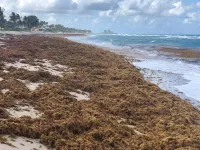(Press-News.org) Satellites launched into outer space could send back improved warnings of dangerous solar storms thanks to a breakthrough in the way scientists use space weather measurements.
Experts from the University of Reading have found that using satellite data that is less reliable but is returned to Earth rapidly can be used to improve the accuracy of solar wind forecasts - which are harmful streams of charged particles sent from the sun - by nearly 50 per cent.
Their research, published today (Thursday, 18 May) in Space Weather, could pave the way for agencies, such as the Met Office, to provide more accurate forecasts for severe space weather, which can cause blackouts and harm human health.
Lead researcher Harriet Turner, from the University of Reading’s Department of Meteorology, said: “We know lots about how to prepare for storms that form on Earth, but we need to improve our forecasts of the dangerous weather we get from space. Space weather threatens our technology-focused way of life as it can cause power grids to fail, damage satellites, such as GPS, and even make astronauts ill.
“Our research has shown that using rapid satellite measurements to forecast space weather is effective. By sending spacecraft far from Earth, we can use this new technique to get better solar storm predictions and ensure we are prepared for what’s to come.”
Simon Machin, Met Office Space Weather Manager, said: “This is a great example of the value that can result through our collaboration with academia. By pulling through scientific research into the operational domain, improved space weather forecasting will ultimately enhance our nation's ability to prepare for and mitigate against space weather events.”
Old dogs and new tricks
To predict space weather, scientists need to forecast the solar wind conditions at Earth. To do this, they combine computer simulations with observations from space to estimate what space weather will be like. This is known as data assimilation. The highest quality observations only become available many days after they are made, as they are processed on the ground and ‘cleaned’, meaning forecasts take longer to achieve.
To obtain forecasts faster, the research team tried using near-real-time (NRT) data. NRT data undergoes no processing or cleaning, meaning it is less accurate but can be made available within a couple of hours. The research team found that forecasts produced using the NRT data still produces reliable predictions and enables greater warning time. This could enable authorities to better prepare for power failures that cost up to 2.1 trillion dollars over a century in the USA and Europe.
To the stars
The scientists behind this new study say using this new technique with upcoming space missions will enable better forecasts.
The European Space Agency (ESA) will launch ‘Vigil’ in the mid-2020s, a first-of-its-kind mission that will monitor potentially hazardous solar activity using a number of UK-built instruments.
By launching the spacecraft into a position 60 degrees behind Earth in longitude, the Met Office will be able to improve space weather forecasts by using data assimilation of the NRT solar wind data.
It is hoped the unique location of Vigil will allow scientists to see the solar wind that will later arrive at Earth, maximising forecast accuracy and warning time.
END
Space missions set to improve solar storm forecasts
2023-05-18
ELSE PRESS RELEASES FROM THIS DATE:
Perfect ‘pathogen’ storm: Vibrio bacteria, Sargassum and plastic marine debris
2023-05-18
A new study uncovers how the interplay between Sargassum spp., plastic marine debris and Vibrio bacteria creates the perfect “pathogen” storm that has implications for both marine life and public health. Vibrio bacteria are found in waters around the world and are the dominant cause of death in humans from the marine environment. For example, Vibrio vulnificus, sometimes referred to as flesh-eating bacteria, can cause life-threatening foodborne illnesses from seafood consumption as well as disease and death from open wound infections.
Since 2011, ...
The importance of social media in corporate social responsibility
2023-05-18
A new study by Dr. Lucie Kvasničková Stanislavská from Czech University of Life Sciences, Prague published in PeerJ Computer Science titled ‘Global analysis of Twitter communication in corporate social responsibility area: sustainability, climate change, and waste management’ has found that social media is an increasingly important tool for companies to communicate their corporate social responsibility (CSR) efforts. The study analyzed over half a million tweets from 2017 to 2022 and identified the key topics and trends communicated in connection with CSR on Twitter.
“Our results aid enterprises in developing communication ...
SCAI releases guidance on management of in-stent restenosis and stent thrombosis
2023-05-18
PHOENIX (May 18, 2023) – The Society for Cardiovascular Angiography & Interventions (SCAI) today release an expert consensus on the management of in-stent restenosis and stent thrombosis. The statement was published online in the Journal of the Society for Cardiovascular Angiography &
Interventions (JSCAI).
In-stent restenosis is a blockage or narrowing that comes back in the portion of the coronary artery previously treated with a stent and remains a common clinical problem despite numerous improvements in stent design and polymer coatings in recent years. In addition to significant health care
costs, it is also associated with an increased risk of death and re-hospitalization. ...
Past climate change to blame for Antarctica’s giant underwater landslides
2023-05-18
Scientists have discovered the cause of giant underwater landslides in Antarctica which they believe could have generated tsunami waves that stretched across the Southern Ocean.
An international team of researchers has uncovered layers of weak, fossilised and biologically-rich sediments hundreds of metres beneath the seafloor.
These formed beneath extensive areas of underwater landslides, many of which cut more than 100metres into the seabed.
Writing in Nature Communications, the scientists say these weak layers – made up of historic biological material – made the area ...
Time of day may determine the amount of fat burned by cold exposure
2023-05-18
Short-term exposure to cold temperatures activates brown fat that burns calories and has become an attractive target to promote cardiometabolic health. Now new research being presented at this year’s European Congress on Obesity (ECO) in Dublin, Ireland (17-20 May) suggests that this biological response differs depending on the time of day and in men and women.
The preliminary study by Dr Mariëtte Boon from Leiden University Medical Center in the Netherlands and colleagues, suggests that cold exposure in ...
Nearly half of adolescents using semaglutide in trial dropped below the clinical cut-off for obesity
2023-05-18
DUBLIN—A new secondary analysis of the STEP TEENS trial presented at this year’s European Congress on Obesity (ECO 2023, Dublin 17-20 May) and published in the journal Obesity shows that almost half (45%) of the adolescents assigned to semaglutide in the trial managed to lose enough weight to drop below the clinical cutoff for obesity.
The study, led by Aaron S. Kelly, PhD, co-director of the Center for Pediatric Obesity Medicine at the University of Minnesota, Minneapolis, and colleagues, also showed almost three quarters (74%) moved down by at least one weight category.
The full STEP TEENS trial, published in 2022 in the New England Journal ...
Women and non-white groups still missing out on top US research prize
2023-05-18
The number of women and non-white people in academic medicine and biomedical research continues to increase, yet the proportion of women among Lasker Award recipients has not changed in more than 70 years, finds a study published by The BMJ today.
And only one non-white woman was identified as having received a Lasker Award over the course of seven decades, the findings show.
The researchers say these results are difficult to reconcile given the ever increasing number of qualified scientists from diverse backgrounds, and they call for more transparency around ...
Prostate cancer ‘test by request’ policies drive overdiagnosis and inequity with minimal benefit, argue experts
2023-05-18
Most high income countries, including the UK, do not have a national prostate cancer screening programme, but instead allow men without symptoms to get a prostate-specific antigen (PSA) test if they wish, after talking to their doctor.
But experts writing in The BMJ today argue that these shared decision policies have led to high rates of PSA testing and clear medical harm, with minimal benefit and inequity.
Andrew Vickers and an international group of colleagues argue that high income countries should either implement a comprehensive risk based approach ...
Tonsillectomy both clinically and cost effective for adults
2023-05-18
Scientists say tonsil removal is both clinically and cost effective for adults who get recurrent severe sore throats.
The biggest study of its kind, carried out by Newcastle University, revealed that patients who had a tonsillectomy had 50% less sore throats over two years, compared to patients who did not undergo tonsillectomy. Publishing today (17 May) in The Lancet, the study was funded by the National Institute for Health and Care Research (NIHR).
Experts also found that a tonsillectomy for those aged 16 years and over was cost effective ...
New measure of quality life for patients with locally recurrent rectal cancer
2023-05-18
This collaborative study between researchers in the UK and Australia is a huge step towards aligning outcome reporting with patient priorities in advanced cancer settings. The study, published in the journal eClinical Medicine (The Lancet Discovery Science), details the development, testing and analysis of this design-specific measure to assess quality of life in patients with recurrent rectal cancer, regardless of treatment intent.
This new measure – called the LRRC–QoL – consists of nine multi-item scales (healthcare services, psychological ...



